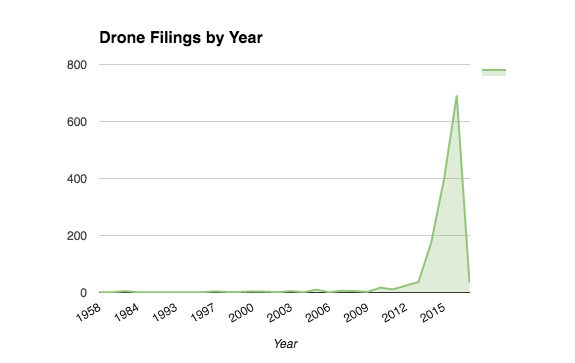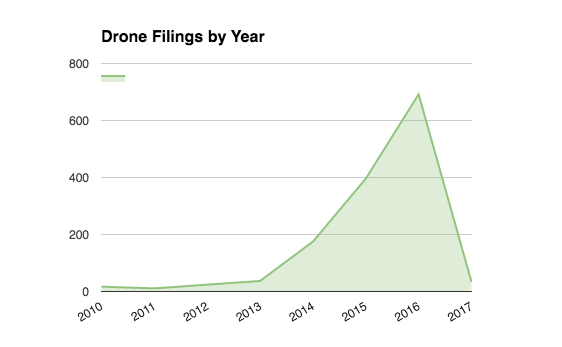Drone Trademark Filings: Droning On or Taking Flight?
In the past couple of years, drones and related legal issues surrounding drones have been hot topics. Major companies like Amazon and Google are coming up with innovative ways to use them, drone enthusiasts are forming groups and meetups, and this past holiday season, they were high on many lists. In fact, 1 in 5 people said they wanted a drone for Christmas this past holiday season, and it was estimated that 1.2 million Americans found them under the tree on Christmas morning. (How many of them were found stuck in some other tree later that day? We don’t have numbers on that.)
Meanwhile, the Federal Aviation Administration and local and state authorities have been struggling to figure out how to regulate, or how not to regulate, drone usage.
As the business world figures out how it will use drones to increase efficiencies, add a new marketing gimmick, or develop new and better content and data from overhead, drones will continue to grow in use, sales, and legal questions. Here at Name Warden, we work with trademarks. So we were interested in whether there had been a big uptick in drone trademark filings as new companies and new products got into the act. We’ve pulled and parsed the USPTO data on drone trademark filings over the years, like we’ve done previously for the uptick in craft beer branding, and for vaping products. Here’s what we found.
Drones flew into the scene earlier than you think
The first mention of “Drone” was in 1958! SN: 89000009 RADAR TRACKING AND CONTROL SYSTEM FOR COMBAT SURVEILLANCE DRONES
Most of the filings we found from 1958 until about 1991 were for military purposes. That’s because the first drone was created for military purposes (more on that below).
Drones can do what?
We learned that the term “drone” does not necessarily refer to flying drones. Here are two examples:
- SN: 78241320 “industrial drones for loading and unloading materials”
- SN: 85078396 AQUA DRONE
Buzz off!
We also found filings for bee products in 1984.
SN: NATURAL BEE PRODUCT OBTAINED FROM DRONE LARVAE AND LARVAL FOODS, SOLD AS AN INTEGRAL COMPONENT OF COSMETIC PREPARATIONS, HAIR LOTIONS, AND MOUTH HYGIENE PREPARATIONS
The word drone in Old English is actually a term for the male honeybee. The first use of the term drone in aviation was in 1936. U.S. Navy Commander Delmer Fahrney was directed to develop target airplanes that were pilotless. The project was inspired by the Royal Navy’s target aircraft, “Queen Bee”. Target airplanes were used in World War II as practice targets for fighters and antiaircraft guns. In the bee world, drones have sort of a mindless existence. The naming of these Remotely Piloted Vehicles (RPVs) was a nod to that of drone honeybees, who seem to have no mind of their own.
Drones in Hollywood
Drone trademark filings for equipment used in movies started popping up in 2007. A typical product description read “Motion picture and television film production, namely, providing remote controlled drone helicopters equipped with specialized cameras for filming purposes; Aerial photography.”
Into the hands of the people
It’s not until 2010 you see marks for drone sales, in the sense that we now think of the word “drone,” in particular with filings for retail distributorship services. This is where the uptake in filings really begins. Here’s a chart showing number of filings per year from 1958 until now.
Here’s a closer look at filings starting in 2010 with the deal development of retail channels for remote-controlled “drone” aircraft.
The big dip this year is because it’s early yet in 2017, with 34 filings so far in 2017 as of the date we collected our data. Combing through filings we see drones for photography, toys, education, surveillance, agricultural surveying, delivery, military use, medical purposes, accessories such as landing pads, drone camps, and catchy phrases like “Do not drink and drone.” The future of drones is wide open!


